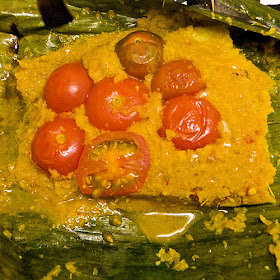I decided to adapt a pepes ikan recipe for a twist on fish tacos. The spice and heat of the pepes ikan makes perfect sense in a fish taco, and the mango salsa with jicama and daun laksa is one that could easily be made in Indonesia. A drizzle of sambal kecap might have been an interesting addition; I'll try it with that next time I make these.
Unfortunately, today was a cold, rainy day more suited to a bowl of pozole than fish tacos. They tasted good, but I was cold and wet from the grill, dreaming of white sand beaches while my feet were as cold as the coldest beer in Bali. Fitting, perhaps, for a recipe entered in the Alaska fish taco contest.
1 12 oz package of Alaskan cod
6 shallots
3 cloves of garlic
2 slices of laos (galingal) about the size of quarters, peeled and chopped
2 slices of ginger, peeled and chopped
2 stalks of lemongrass, chopped, using only lower third, tough outer layers removed
2 tsp sambal oelek (Indonesian chili paste)
4 kemiri (candle nuts)
1 tsp ground turmeric
2 tsp light brown sugar
1/2 tsp salt
2 tsp lemon juice
2 tsp vegetable oil
6 cherry tomatoes, sliced
banana leaves (or aluminum foil) for wrapping the fish
mango salsa
1 cup of mango, preferably fresh, diced
1 shallot, small dice
1 to 2 red chilies, seeded and cut in small dice
1/2 small jicama, diced
1/4 cup of laksa leaves (Vietnamese rau ram) finely chopped
juice of 1/2 lime
red cabbage, finely sliced
avocado, sliced
tortillas
Add the shallots, garlic, laos, ginger and lemongrass to a food processor with a metal blade and chop fine. Add sambal, kemiri, turmeric, brown sugar, salt and lemon juice, blending to a fine paste. Heat oil in a frying pan and fry the spice paste for several minutes until fragrant, but take care not to brown it. Remove the paste to a bowl and allow to cool.
On an 8 x 12 inch banana leaf (or aluminum foil) lay one fillet of cod. Spread the fish with some of the cooled spice paste. Turn it over and spread the other side. Top the fillet with some of the sliced tomatoes. Fold the banana leaf into a packet, using toothpicks to seal the folds. (If using banana leaves, it may be necessary to use two leaves to ensure your packet doesn't leak.) Follow the same procedure for the remaining fillets.
Grill on a medium-hot grill for 20 to 25 minutes, flipping the packet over halfway through the cooking time.
While the packets are being grilled, prepare the other elements. Make the salsa by mixing together the ingredients in a bowl. Add more lime juice if necessary.



















